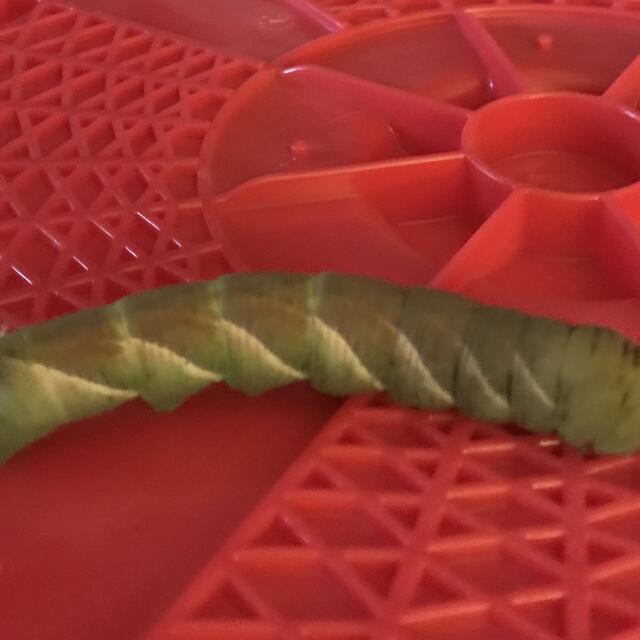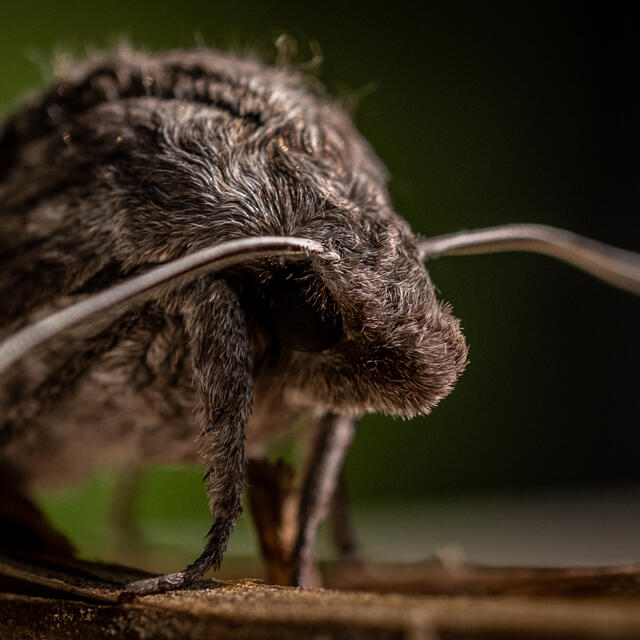National Moth Week is July 20-28, 2024!
Moths are amazing creatures. Take photographs and share your moth sightings with us to document the moths where you live.
Great ash sphinx
Sphinx chersis (Hübner, 1823)
Family: Sphingidae
Subfamily: Sphinginae
Identification: Forewing is soft dark gray to blue-gray with a series of black dashes, one of which reaches the wing tip. Hindwing is black with blurry pale gray bands.
Wing Span: 3 9/16 - 5 1/8 inches (9 - 13 cm).
Life History: Fully-grown caterpillars pupate in burrows in the soil. Caterpillars from the second generation pupate and overwinter in their burrows.
Flight: . Two broods in the south from May-June and from July-August.
Caterpillar Hosts: A variety of plants including lilac (Syringa vulgaris), quaking aspen (Populus tremuloides), ash (Fraxinus), and privet (Ligustrum).
Adult Food: Deep-throated flowers such as Japanese honeysuckle (Lonicera japonica), bouncing bet (Saponaria officinalis), dogbane (Apocynum), and evening primrose (Onagraceae).
Habitat: A wide variety of woodlands and arid western scrublands.
Range: Mexico north through most of the United States, but rare in the Gulf States.
Conservation: Not usually required.
NCGR: G5 - Demonstrably secure globally, though it may be quite rare in parts of its range, especially at the periphery.
Management Needs: None reported.
Get your BAMONA Gear!
Please donate!
We depend on donations to keep Butterflies and Moths of North America freely available. We want to express our gratitude to all who showed their support by making a contribution this year. You can donate to support this project at any time.
Advertise with us!
Do you have a product or service that you think would interest BAMONA users? If you would like to advertise on this website, contact us by email, or use the contact form and select the "Advertising" category.
Verified Sightings
Displaying 1 - 24 of 469 verified sightings

Observation date: Sep 02, 2013
Submitted by: Dani Pereda
Region: Riverside County, California, United States
Verified by: Ilona L.
Verified date: Jan 04, 2024

Observation date: Aug 17, 2023
Submitted by: pgrew1@unl.edu
Region: Penobscot County, Maine, United States
Verified by: Sue Gregoire
Verified date: Aug 21, 2023

Observation date: Jul 28, 2022
Submitted by: PopiRob
Region: Bernalillo County, New Mexico, United States
Verified by: jwileyrains
Verified date: Aug 13, 2023

Observation date: Aug 10, 2022
Submitted by: clbelben
Region: Bernalillo County, New Mexico, United States
Verified by: jwileyrains
Verified date: Aug 10, 2023

Observation date: Jul 22, 2023
Submitted by: rocksnstars
Region: Oxford County, Maine, United States
Verified by: Sue Gregoire
Verified date: Jul 23, 2023

Observation date: Aug 28, 2017
Submitted by: RvbDread
Region: San Diego County, California, United States
Verified by: mcduck
Verified date: Jul 22, 2023

Observation date: Jun 19, 2023
Submitted by: Gonzo
Region: San Bernardino County, California, United States
Verified by: mcduck
Verified date: Jul 15, 2023

Observation date: Jun 15, 2023
Submitted by: mothman420
Region: Alberta, Canada
Verified by: davidwdroppers
Verified date: Jun 24, 2023

Observation date: May 29, 2023
Submitted by: Okjini
Region: Lincoln County, Maine, United States
Verified by: Sue Gregoire
Verified date: May 31, 2023

Observation date: Jul 09, 2022
Submitted by: Canuckgirl
Region: Nova Scotia, Canada
Verified by: Sue Gregoire
Verified date: Jan 17, 2023

Observation date: Jul 18, 2022
Submitted by: J_Martineau
Region: Santa Cruz County, Arizona, United States
Verified by: J_Martineau
Verified date: Dec 12, 2022

Observation date: Jul 16, 2022
Submitted by: J_Martineau
Region: Socorro County, New Mexico, United States
Verified by: J_Martineau
Verified date: Dec 07, 2022

Observation date: Aug 27, 2022
Submitted by: TommyGuy_75
Region: Saskatchewan, Canada
Verified by: Tom Middagh
Verified date: Nov 18, 2022

Observation date: Aug 12, 2022
Submitted by: kellyhorse
Region: Alberta, Canada
Verified by: davidwdroppers
Verified date: Oct 28, 2022

Observation date: Sep 30, 2022
Submitted by: cahikerchick
Region: Washington County, Utah, United States
Verified by: J_Martineau
Verified date: Oct 10, 2022

Observation date: Jul 15, 2021
Submitted by: crystalcat2575
Region: Yavapai County, Arizona, United States
Verified by: kellyrichers
Verified date: Sep 29, 2022

Observation date: Aug 07, 2017
Submitted by: BeaLaporte
Region: Ontario, Canada
Verified by: jwileyrains
Verified date: Sep 28, 2022

Observation date: Aug 12, 2022
Submitted by: luvsleemans
Region: British Columbia, Canada
Verified by: jwileyrains
Verified date: Sep 28, 2022

Observation date: Aug 14, 2022
Submitted by: PSheppard
Region: Ontario, Canada
Verified by: jwileyrains
Verified date: Sep 28, 2022

Observation date: Jul 26, 2021
Submitted by: NJSqueak
Region: Riverside County, California, United States
Verified by: mcduck
Verified date: Sep 05, 2022

Observation date: Aug 22, 2022
Submitted by: Hollyberrybug68
Region: Ravalli County, Montana, United States
Verified by: J_Martineau
Verified date: Aug 22, 2022

Observation date: Jul 18, 2018
Submitted by: Jill1229
Region: Grand Forks County, North Dakota, United States
Verified by: jwileyrains
Verified date: Aug 13, 2022

Observation date: Jul 26, 2022
Submitted by: jerzey
Region: Mendocino County, California, United States
Verified by: jwileyrains
Verified date: Aug 09, 2022

Observation date: Jul 13, 2022
Submitted by: Zancan
Region: Hennepin County, Minnesota, United States
Verified by: Tom Middagh
Verified date: Jul 26, 2022
- 1 of 20
- next ›









